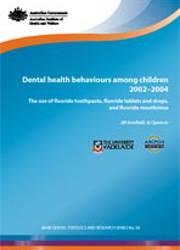Summary
The majority of Australian children engage in oral health behaviours that are in line with current Australian guidelines on the use of fluoride products.
Brushing with fluoride toothpaste is the most common oral health behaviour of Australian children. Less than 5% of children brushed less than once a day and nearly all children brushed their teeth with fluoride toothpaste.
A number of small but important differences in toothbrushing practices, use of fluoride tablets and drops, and use of fluoride mouthrinse, were seen across family income, parental education and residential remoteness groups.
A study of almost 17,500 children from four Australian states (Queensland, Victoria, South Australia and Tasmania) conducted across 2002–2004 provided comprehensive information on the dental health behaviours of Australian children. These data were collected from children using the school dental service across the years 2002–2004. Children were aged from 5 to 15 and data were weighted to the age, sex and state estimated resident populations. Due to the importance of fluoride to improved oral health, information was collected on the use of fluoride toothpaste, fluoride tablets and drops, and fluoride mouthrinse. The reported behaviours have been compared to the recommendations in The use of fluorides in Australia: guidelines (ARCPOH 2006).
This study expanded upon the existing Child Dental Health Survey, a surveillance survey that the Australian Institute of Health and Welfare’s Dental Statistics and Research Unit (DSRU) conducted (Armfield, Roberts-Thomson & Spencer 2003).
Over 99% of children brushed their teeth with toothpaste, with more than two-thirds of children brushing their teeth the recommended 2 times per day. Children from higher income families brushed their teeth more often, were more likely to be using children’s toothpaste at younger ages, were more likely to use a small toothbrush at a younger age and were less likely to use a large amount of toothpaste when brushing in comparison to children from lower income families. Differences in toothbrushing behaviours were also apparent across parental education, family income and residence remoteness groups.
About 10% of children had ever used fluoride tablets or drops and the majority of children used them for less than 3 years. Children from higher income families were more likely to have used fluoride tablets or drops and, on average, used them for longer compared with children from lower income families. However, children from lower income families who used fluoride tablets or drops consumed them more frequently than did children from higher income families.
As most urban centres in Australia have fluoridated tap water, the use of fluoride tablets and drops was more common in rural than urban areas. A higher proportion of children residing in rural areas chewed and swallowed fluoride tablets than did children from urban areas.
The use of a fluoride mouthrinse was more common among older children. However, a low percentage of children at any age used a fluoride mouthrinse. Less than a quarter of children using a fluoride mouthrinse used it every day. Almost two-thirds of children who used a fluoride mouthrinse did so only a few times a week or infrequently.



